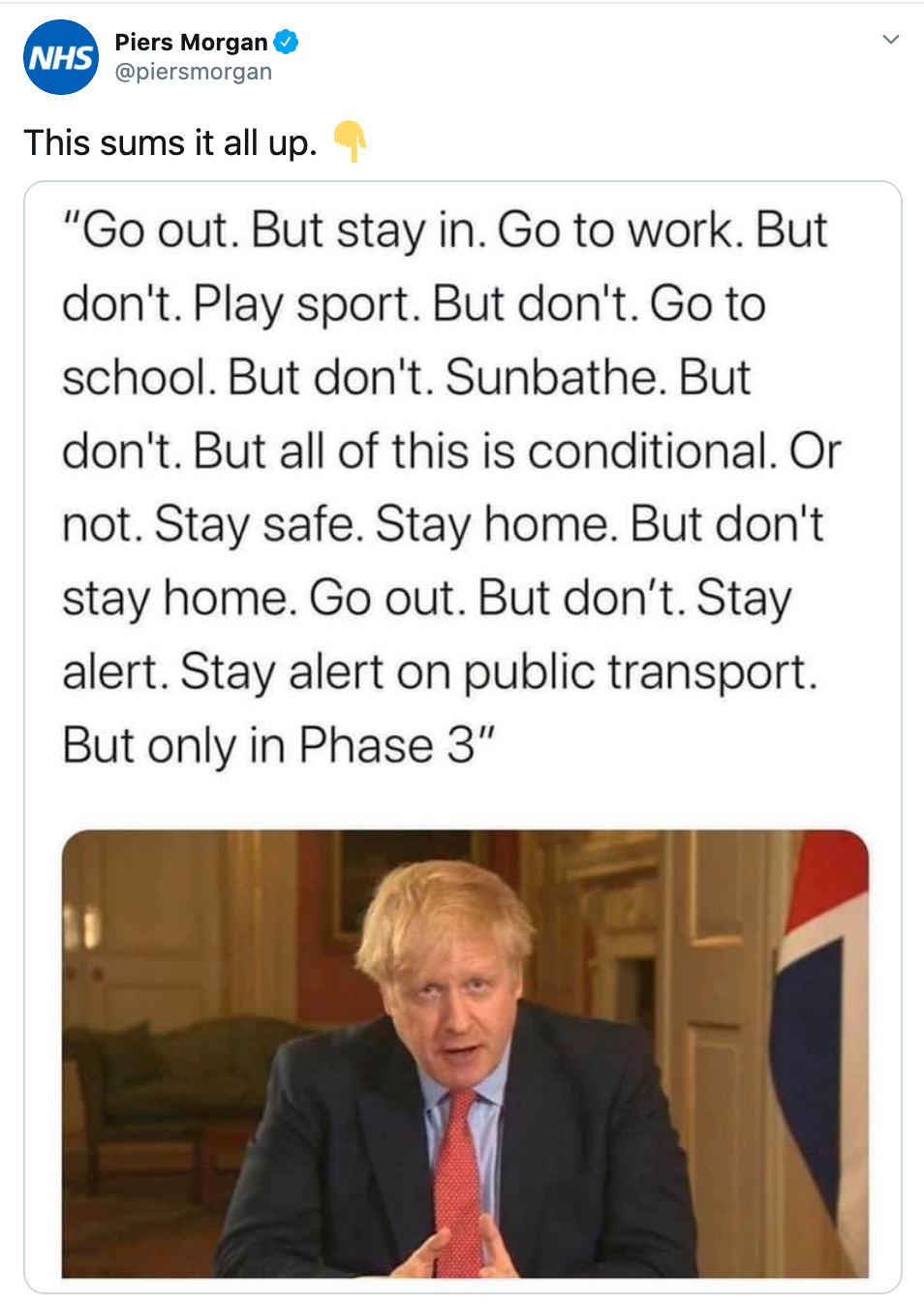Let’s get back to basics
As PRs one of the first lessons we learn when starting our careers is the importance of the seven Cs of communication. We’re told that with any messaging it’s important to be clear, concise, concrete, correct, coherent, complete and courteous – it’s a simple, formulaic structure we follow and yet, one the UK Government seems to have overlooked during the current pandemic.
Over the past few weeks, there’s been a lot of talk about the need for clarity from the Government – whether that’s on their new ‘Stay Alert, Control the Virus, Save Lives’ slogan or Dominic Cummings appearing to undermine the original lockdown rules; the messaging has been inconsistent and at times, confusing to the public.
Effective communication should encourage or influence behaviour change. Everything from downloading an app to putting your bins out on a different day – communication should make you take or change a specific action, thought or behaviour.
Confusing comms?
The government’s new coronavirus recovery plan is a 60-page, three-step strategy for gradually lifting the UK’s lockdown and according to Health Secretary, Matt Hancock, the public “really understand” the government’s new guidance. Addressing the supposed confusion, Hancock argued that concerns about the government’s messaging strategy were “second-order” amid the wider issues brought on by the pandemic.
The reaction on social media tells a different story though, with many redesigned ‘Stay Alert’ messages trending mere hours after the original announcement – often with humorous results:


The way the messaging was broadcast into the public domain by pre-briefing journalists, and the disjointed nature of the rollout, was also criticised by many, with people across the country increasingly taking to social media to continuously air their gripes at the government’s comms approach.
In recent days, trending topics and hashtags on social media, have included: ‘FlounderingBoris’, ‘SackDominicCummings’, ‘CummingsAndGoings’ and ‘CumGate’.
The Prime Ministers approval rating also plunged by 20 points in four days amid Dominic Cummings scandal. Public opinion of individual ministers such as Matt Hancock and chancellor Rishi Sunak also fell, with both ministers publicly backing Mr Cummings and his actions during lockdown. During the same period, approval ratings for Labour leader Keir Starmer and medical advisors Chris Whitty and Patrick Vallance increased.
A revised approach?
So, with so much negativity currently online – should the government be revising their recovery communications strategy?
At No Brainer, we think so. A marked improvement needs to be made, to move away from ambiguous, open to interpretation messaging, which has caused this damaging groundswell in public opinion. The subsequent storm in traditional media and via social media would lose a lot of impact, if clearer messaging was delivered across all available channels – everything from emails to news conferences, social media to paid media advertising – all should be readdressed to become more consistent and coherent.
At the moment, the government is not only dealing with a national pandemic but also a crisis of confidence. It’s a difficult and multifaceted problem, but like any PR crisis, it’s one that should be managed through honest communication, with a human approach. In our previous posts, we’ve spoken about the 8 steps to managing a PR crisis and would advocate any brand or organisation to follow these fundamental steps when confronted by an emergency – however big or small.
Of course, watching as an outsider, it’s easy to make recommendations and weigh in on a topic that’s already widely debated; however, the recovery comms is vital to our nation’s health and safety, and whilst it certainly requires a nuanced approach, it also could benefit from a return to basics.
The public requires clarity as we look to come out of lockdown. We need to understand what’s safe and what’s not – all in simple terms that leave little room for individual interpretation. Whilst the new slogan is positive and helps to lift the mood of the nation, it requires too much explanation and therefore becomes ineffective.
Moving forward, we would hope to see future messages, slogans and advice follow the seven Cs. They should all be stand-out key messages and communicate only one idea per message. We shouldn’t want people to have to read between the lines anymore. They should be brief and void of ‘filler words’ that dilute the key takeaway.
Whilst the detail is vital – especially during a national pandemic – don’t overload your messaging with this. Stick to concise facts, and make sure these always directly relate back to your key messaging.
Always double-check for mistakes too, and ensure any spokesperson is completely briefed, with all the relevant information and details to hand – even if these don’t form part of their initial speech. Connecting the dots for the public allows them to follow your journey of thought and maintain the tone and flow of your message. Lastly, don’t forget to be courteous with all of your communications. A friendly, empathetic and honest tone can help to improve the public’s confidence in your messaging and also avoid questions around mistrust.
For our government going forward, a review of its comms recovery strategy is vital. They need to have a unified approach to leading the UK public and deliver this through improved messaging. We hope over the coming months they readdress the public’s concerns and return back to the basics of communication.









